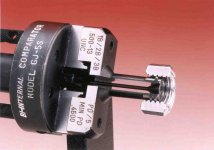i_r_machinist
Titanium
- Joined
- Apr 12, 2007
- Location
- Dublin Texas
We cut a butt load of stem nuts here, like 1"-.2p-.4l lh acmes. Normally I will ask for the matching stem and fit the nut to it, but sometimes we can't do that. If I was in a production shop I would get go-nogo gages. Over the years I've built up a collection of old stem segments that I keep in a drawer for fitting, but every now and I then get thrown a curve ball. So, How to measure pitch diameter on internal acme threads?
Thanks in advance
i_r_
edit: I just thought of something. I used to work in a shop that had a "gagemaker" system.
Thanks in advance
i_r_
edit: I just thought of something. I used to work in a shop that had a "gagemaker" system.



